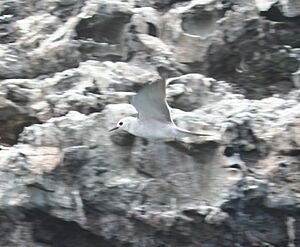Blue noddy facts for kids
Quick facts for kids Blue noddy |
|
|---|---|
 |
|
| Conservation status | |
| Scientific classification | |
| Genus: |
Anous
|
| Species: |
ceruleus
|
| Synonyms | |
|
Procelsterna cerulea (Bennett, 1840) |
|
The blue noddy (also called hinaokū or manuohina) is a small seabird. Its scientific name is Anous ceruleus. You might also hear it called the blue-grey noddy. It belongs to the Laridae family, which includes gulls and terns.
This bird lives in warm, shallow ocean areas. You can find it in places like Hawaii, the Cook Islands, Fiji, and many other islands across the Pacific Ocean. Sometimes, it even flies to Australia or Japan by accident! Its favorite home is the open, shallow seas in tropical and subtropical parts of the world.
Contents
Understanding the Blue Noddy's Family Tree
Scientists use a system called taxonomy to name and group living things. This helps us understand how different species are related.
How the Blue Noddy Got Its Name
The blue noddy was first officially described in 1840. A scientist named Frederick Debell Bennett gave it the name Sterna cerulea. The word ceruleus is Latin and means "dark blue," which fits the bird's color!
Changes in Its Scientific Group
For a while, the blue noddy was placed in a group called Procelsterna. But in 2016, scientists did a special study. They looked at the birds' DNA to see how closely they were related. This study showed that all the different types of noddies actually belong together in one main group, or genus, called Anous. So, the blue noddy was moved to the Anous genus.
The Necker Island Tern Mystery
In 1902, a research ship called the USFC Albatross saw a seabird near Necker Island in Hawaii. Scientists first thought it was a completely new type of bird! They even gave it a new name, Procelsterna saxatalis, and called it the Necker Island tern. Later, they realized it was actually just a specific kind, or subspecies, of the blue noddy.
Different Kinds of Blue Noddies
There are five different subspecies of the blue noddy. Think of subspecies as slightly different versions of the same bird, often living in different places:
- A. c. saxatilis: Found from Marcus Island and the northern Marshall Islands to the Northwestern Hawaiian Islands.
- A. c. ceruleus: Lives around Kiritimati Island and the Marquesas Islands.
- A. c. nebouxi: Seen in the Phoenix Islands, Tuvalu, Fiji, and the Samoan Islands.
- A. c. teretirostris: Found in the Tuamotu Archipelago, Cook, Austral, and Society Islands.
- A. c. murphyi: Lives in the Gambier Islands in French Polynesia.
The grey noddy (Anous albivitta) is a close relative. It lives in areas south of where the blue noddy is found. These two birds used to be considered the same species, but now scientists usually treat them as separate.
What Does the Blue Noddy Look Like?
The blue noddy is a small bird. It is about 25 to 28 centimeters (10 to 11 inches) long. Its wingspan, which is how wide it is with its wings spread out, is about 46 to 60 centimeters (18 to 24 inches).


